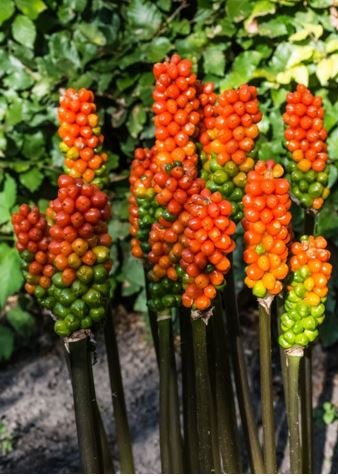This plant always garners favorable comments when people notice it, especially in mild winters when the interesting leaves emerge as soon as the ground thaws. It can also be grown as a houseplant which prospers in low winter light, but it will go dormant for the summer.
About
Also called Italian Arum or Cuckopint (arum italicum)
This is a close southern European relative of our native Jack-in-the-Pulpit. It grows from a thickened root called a tuber from which arises a cluster of arrowhead-shaped leaves about a foot tall with distinctive and attractive silver to white venation over the green. Once the leaves are fully open, one or more blossoms arise from the ground and produce a large white handkerchief-like bloom beneath the leaves which persists for a week or two. During the heat of summer, the foliage dies back, but the plant returns in the fall with a cluster of bright red berries on a spike. Over time the plant will produce a large colony.

Gardener Tip For Growing Italian Arum Italicum
Arum italicum grows well in shady or partial sun and has been recommended as a good choice for growing among hostas. Although its native range is considerably warmer than Warren County, it grows well here. This plant is also sometimes grown as a houseplant. Although it is more tolerant of standing water than most garden plants, it prefers moist, but well-drained humus-rich soil, much like might be found in a forest setting. It has few pests or diseases and needs little care except the occasional weeding and may not even need that when grown in shade. It will spread slowly over the years. In warmer climates, it is more aggressive and can serve as a ground cover. In some places, like the Pacific Northwest, it has become invasive, however, our climate tends to prevent it from spreading too rapidly.
It grows well from seeds or root divisions taken following the bloom period.
This plant always garners favorable comments when people notice it, especially in mild winters when the interesting leaves emerge as soon as the ground thaws. It can also be grown as a houseplant which prospers in low winter light, but it will go dormant for the summer.
Take Caution
All parts of this plant are toxic, so keep young children away from it.
Written By: Penn State Extension Master Gardener Dan Sorensen

